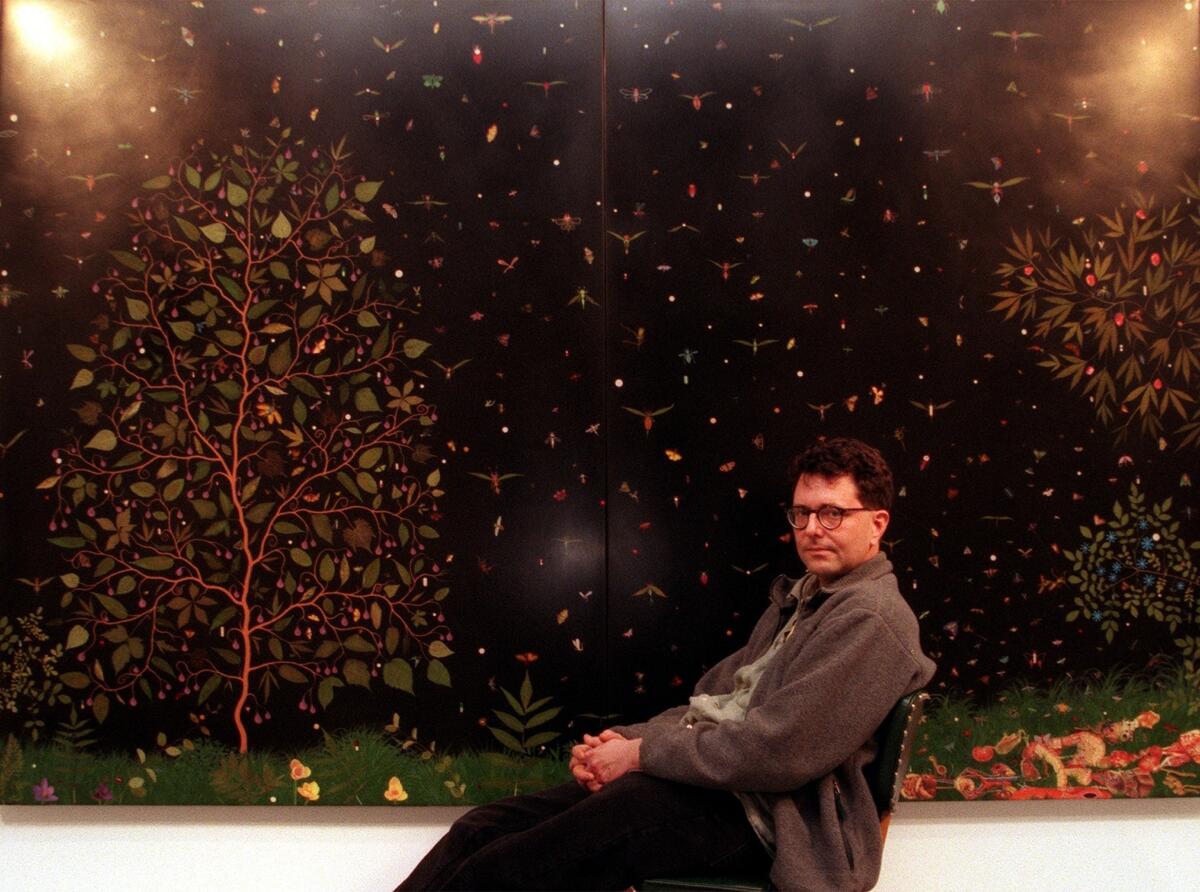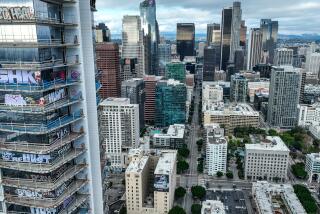‘Get out!’ said the cops: Art pioneers of downtown L.A. share memories of building a scene
- Share via
A performance that nearly gassed its audience. A video that captured cars bumping into each other on the 6th Street Bridge. And a Mexican stage show about a 19th century novel that featured topless vedettes.
My story last week about the history of the downtown Los Angeles arts scene in the 1970s and ‘80s drew a lot of emails from readers sharing their memories and gently reminding me of the people and events that were not included.
For example: the early shows of PØST gallery, which opened in the mid-1990s, or the exhibitions staged by legendary printer Richard Duardo, of Modern Multiples, who created editions for figures such as Keith Haring and David Hockney.
There were too many interesting stories to fit into a single article, but some of the shared memories were so good I couldn’t keep them to myself. So I’ve gathered some of the stories here — along with some of the interesting bits that got left on the cutting-room floor. A look back at art and life in downtown L.A.:
Stephen Seemayer, artist, filmmaker: “It was very bleak. There wasn’t crack yet. There wasn’t AIDS. But there was a sense of desolation. It was so desolate that even the cops didn’t really want to deal with you. I was 3 to 4 blocks away from the Newton Division and it’s famous in the LAPD. They were called the ‘Shootin’ Newton.’ I was like 22 at the time. I would be there at my studio and they’d see me out of my car and they’d roust me and said, ‘What are you doing in this neighborhood?’ And I’d say, ‘I live here.’ And they’d say, ‘Get out!’”
Lisa Adams, painter: “It was really tough living in those years. Our only market was Food 4 Less on First Street in Boyle Heights. We’d all go shopping in the middle of the night — covered in paint or looking homeless — because it was 24 hours. At one point a guard asked me in all sincerity if there was a bus that brought us all over from wherever at that time at night!
“But there was a real generosity of spirit, too. I had been commissioned to paint a BMW ArtCar for ArtLA93 in 1993 at the Convention Center. BMW of North America helped me find an abandoned space in which to paint the car that was near the Convention Center. There was not sufficient electricity or light and we had to use too many extension cords to run the generator that powered the spray gun. So Joy Silverman at LACE [Los Angeles Contemporary Exhibitions] was kind enough to offer us their space in between exhibitions so that we could spray indoors in a safe place with great lighting and electricity.”
Marnie Weber, artist, member of the band Party Boys: “We decided we would have an art show in our building. It was just ourselves on Spring St. We invited everyone we knew to submit a piece. I was taking a class with Chris Burden and I said, ‘Do you want to show a piece?’ And he said, ‘Sure.’ And he shot bottle rockets across the street from our roof. And the cops didn’t care. That was just the kind of thing that would happen.
“I remember our first gig [as the Party Boys]. We said, ‘Where is the least likely place you’d play?’ So we picked a gas station at midnight on a Wednesday. Then we had to change location. So we moved to a parking lot that had been painted turquoise. We rented generators and did play Wednesday at midnight. And there was quite a few people — like 25. In those days, you were happy if 25 people showed up.
“Then we played at a bar across the street called Jacaranda’s. We walked in and offered to play for free. We would play for beer. We got a fair amount of people coming to our shows, from downtown, from Hollywood, East L.A. We started inviting other bands like the Minutemen and punk bands from the period.
“Then Marc Kreisel bought the American Hotel [home to Al’s Bar] and we said, ‘Why don’t you have a show?’ He said, ‘If you build a stage I’ll do it.’ So we built a stage.”
Brett Goldstone, multimedia artist: “I remember we were all in the Cotton Exchange show organized by LACE in 1984. Fred Tomaselli did a great kinetic piece. It was these animatronic legs in a dark room. When you walked in there was a mat that had a switch built in and it made the legs jump. It was kinda funhouse — scary, too.
“Chico MacMurtrie did a huge performance up in the ceiling that you saw as you entered the building. It was a kind of this enormous spider web made out of masking tape, I think. It was growing all through the opening. There was so much stuff in the show. I did a kinetic piece of a guy sitting at a table stuffing himself with fast food, arms flailing. Kathy Norklun did a spread in Spectacle magazine about all of the kinetic stuff.
“I did another piece under my nom de guerre, Art Attack, which I used at the time for all of my guerrilla pieces. It was a big banner (30’ x 20’) that I hung on the building the night before by breaking into the upper floors that were locked. It was a rather emotional response to a scene I had witnessed walking home to Chinatown from my friend’s studio on Broadway and 5th Street.
“There was a drunk, homeless guy on the ground at a hot dog stand and there were three or four cops standing around laughing at him as they whacked him with their batons, goading him to stand up. It went on for a few minutes and I wanted I to say something but I had learned that this was a good way to get whacked myself. I was furious. So I went on home and painted this big scene of what I had seen in very simple cartoonish style so as to be read at a large distance.
“It was hanging on the building for a few days when I got a call from [LACE Director] Joy Silverman telling me I had better take it down as the police had come and closed down the show. They had claimed it was for a paperwork issue but it was understood that the banner was the problem. I removed it and the show opened again. I rehung it the night of the closing party just to show the LAPD that we were still on to their brutality toward the homeless in the downtown area.”
HK Zamani, artist and gallerist, PØST: “We had the opening of our first show, ‘Bumpy,’ on Sunday, September 10, 1995. We were then located in a large brick and stucco building on Seventh Place. It was a group show featuring work by Nancy Evans, Pauline Stella Sanchez, Michelle Fierro, Anders Lansing, Leonardo Bravo, David Lloyd and myself. There was also a solo show of paintings by Leonardo Bravo.
“On the following Wednesday we had our first visitor. He said, ‘Good little shows.’ After signing the guestbook I realized he was [Times critic] Christopher Knight. He sent Susan Kandel to write about the show. It got written up in all the other publications, too. Everything was hard copy then. But I hold Christopher responsible for getting PØST on the map.”

Artist Fred Tomaselli with his work at the Christopher Grimes Gallery in the late 1990s. Though he now lives in New York, the artist was part of the downtown scene in the early 1980s.
Fred Tomaselli, painter, multimedia artist: “Mark Pauline did a performance on one of the bridges going into East L.A. There was a lot going on down there. There was this performance artist Stelarc, he hung himself with fish hooks off of one of the bridges just long enough to get a photo. He started hanging out at Gorky’s Cafe [where I was the manager] and I remember I booked him to do a performance at Gorky’s. It was this thing with this robotic third hand. That was very alienating to the customers.”
Big Swede, musician, composer, songwriter: “I’m Swedish. I was here in music school and then I decided to move to L.A. at the end of ’94. I lived on the West Side, I lived in a few areas. But I’ve lived in downtown since 2000. I have a recording studio and place on Spring Street.
“When I moved here, I had seen this mysterious guy many times when walking on Spring Street. The street was pretty underground back then. The area was basically empty after 7pm daily. But I had seen this guy and I had the vibe that he was doing something. He had that feel to him.
“One day I introduced myself. I had no idea that it was Gronk, the true artist-pioneer on Spring Street. He’s been there since the ‘70s. The first time I walked into his building, I was blown away by the hallways covered by his art, from floor to ceiling. It’s like living and being inside art. Total art!
“Now we have coffee daily at our local coffee spot on Spring Street. He is there with Tanner Goldbeck, who is also a great artist, and they are there every morning doing smaller art pieces. They call it ‘coffee art.’ I always get inspired by them.”
Find me on Twitter @cmonstah.
More to Read
The biggest entertainment stories
Get our big stories about Hollywood, film, television, music, arts, culture and more right in your inbox as soon as they publish.
You may occasionally receive promotional content from the Los Angeles Times.











